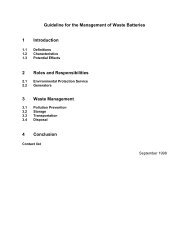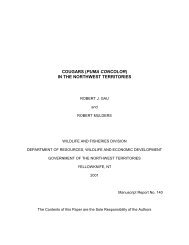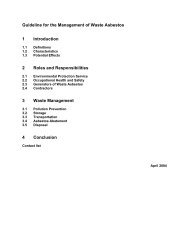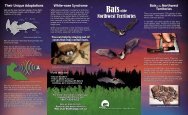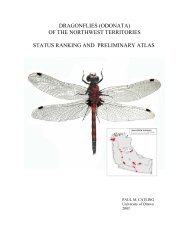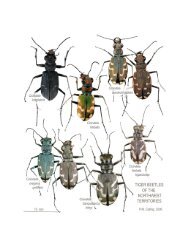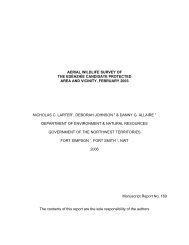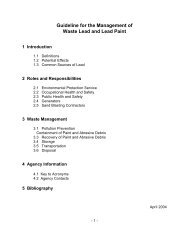Standard Operating Procedure (SOP) - Environment and Natural ...
Standard Operating Procedure (SOP) - Environment and Natural ...
Standard Operating Procedure (SOP) - Environment and Natural ...
- No tags were found...
Create successful ePaper yourself
Turn your PDF publications into a flip-book with our unique Google optimized e-Paper software.
<strong>St<strong>and</strong>ard</strong> <strong>Operating</strong> <strong>Procedure</strong> (<strong>SOP</strong>)<br />
Capture, H<strong>and</strong>ling & Release of Bears<br />
Wildlife Care Committee Primary Author: Dr. Marc Cattet Version 2 - 2011<br />
such case, movement of the animal should be confirmed by detecting<br />
change in its radiolocations.<br />
Although most telemetric devices are equipped with motion-sensitive<br />
mortality sensors, these alone are not adequate for confirming movement of<br />
the released bear <strong>and</strong> should not be used as a substitute for visual<br />
observation or radiolocation in the immediate period following capture.<br />
Activation of the sensor may not always occur within the programmed time<br />
because of intermittent movement of the collar following death caused by<br />
animals feeding on the carcass. Detailed examination of a carcass that has<br />
been scavenged extensively is unlikely to provide any insight into the cause<br />
of death.<br />
Researchers should monitor bear movements 3 months post capture.<br />
This will allow researchers to gather information about behavior <strong>and</strong><br />
movements of bears after anesthesia. Further, it may determine if there is<br />
increased movement of bears into urban areas, due to adverse effects of<br />
capture.<br />
4.6 Euthanasia<br />
Recommendations:<br />
The investigator must be prepared to humanely kill any animal in the field<br />
that is suffering intolerable pain, irreversible injury, or distress as a result<br />
of capture or h<strong>and</strong>ling procedures, or experimental intervention.<br />
Personnel should know how to perform the procedure, if required, <strong>and</strong> should<br />
have the appropriate equipment available at all times during capture<br />
operations.<br />
A detailed report of the euthanasia must be written <strong>and</strong> every effort must<br />
be made to salvage the hide, skull, <strong>and</strong> other parts legally required, <strong>and</strong><br />
submit these with the report to a wildlife officer as soon as possible.<br />
Acceptable methods of killing bears are as follows:<br />
a) Gunshot<br />
- A shot to the brainstem of an animal produces a quick <strong>and</strong><br />
humane death, but is best attempted when the animal is<br />
immobilized by injury or drug.<br />
- In free-ranging situations, or where the intact brain is required<br />
for laboratory testing (e.g., rabies), gunshot to the heart <strong>and</strong><br />
lung area may be more appropriate.<br />
b) Exsanguination (bleeding)<br />
- This method is considered humane if performed on a deeply<br />
anesthetized animal.<br />
- The technique requires bleeding the anesthetized bear by<br />
slicing deeply across the throat to sever the carotid arteries.<br />
c) Intravenous injection of concentrated potassium chloride<br />
23



